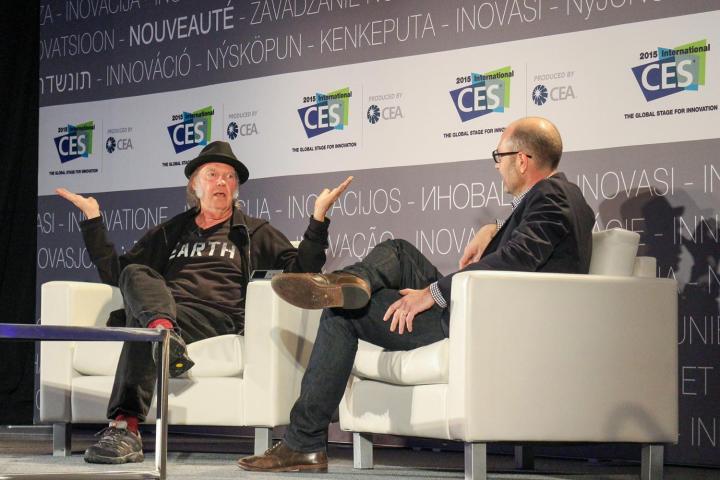
“Pono is a long-term, slow reawakening,” Young said. “And this is the beginning.”
Young showcased his usual affably sarcastic conversation style in answering a variety of questions about the relevancy of high resolution audio during the hour-long interview.
Highlights included Young’s views on the difference between CD-quality sound and higher resolution wave files (“Science says it doesn’t matter, but who cares about science?”); his undeterred love for analog music (“I don’t think anything can sound better than vinyl”); and the importance of the MP3 (“The MP3 is great. You can recognize the song you’re listening to.”).
“Pono is a long-term, slow reawakening,” Young said. “And this is the beginning.”
That last tongue-in-cheek retort was made with no real vitriol about low-resolution audio files, but it did serve to illustrate what Young sees as all that’s wrong with the current state of music, and the rock icon’s appreciation for rich and nuanced audio recordings.
“It’s gotta be fun,” Young said. “If it’s not fun it’s not worth doing. Music is about having a good time feeling your soul, whether it makes you laugh or it makes you cry, just so long as you feel as much as you can. That’s the mission of Pono.”
To Young, every effort to reproduce music in the digital realm is about trying to capture the essence of music in the analog form. That’s no great revelation, as the veteran musician has been raging against low-resolution audio for years. But perhaps most interesting was what he revealed about the plans for the future of the Pono brand as a whole — not just the PonoPlayer.
Young certainly has faith in the device, saying it was designed by “a master, a genius.” However, even though Pono has put out around 20,000 PonoPlayers with more on the way, Young sees the company as anything but an equipment manufacturer.

“PonoPlayer is the start,” Young said. “If you want to license the name, Pono will certify you, whether [you’re creating] a phone, or any other device … we’re sharing all of our technology, if you want to be certified we’ll show you how to do it. Any manufacturer that wants to make this kind of quality, we’ll show you how to do it.” Of most importance to Young, it would seem, is that Pono’s high-resolution technology is proliferated throughout the musical realm.
It’s also important to understand that the PonoPlayer is just one small part of the PonoMusic ecosystem. Besides the technology, the underlying value for Neil and his cohorts seems to be the collection, restoration, and curation of the highest quality digital audio available. To that end, the PonoMusic website has already secured over 2 million songs, and the company is working on securing more.
“Music lovers always want to hear the best. It’s about freedom of choice,” Young said. “We supply the music.”
That statement led to a question about the reason smartphone companies like Apple have so far refused to put higher resolution components and technologies into their devices.
“So far, they’ve chosen not to,” Young said. “The beauty of this whole project is, all we’re doing is saying ‘Hey, music could be a lot better.’” Young also claims that one of the reasons the music industry is in such decline is due to the lack of a visceral, soulful connection to low-resolution audio.
“Music lovers always want to hear the best. It’s about freedom of choice.”
“The music world has taken a huge dump, so maybe there’s a connection. So if Apple decided to do this, maybe they do their own version … whatever they want to do it’s a home run for music. Unless they screw it up, and try to put something on it so that they can own it — I’m calling it out,” Young said. “Proprietary formats are not a good thing.”
Instead of a player or a website, it seems, Young sees Pono as a standard — a stamp of sorts that represents high quality wherever it shows up.
As for Young’s immediate future in music, aside from his work with Pono, he also revealed that he will continue his prominent musical activism. His next effort is a collaboration album with Willie Nelson’s sons called “The Monsanto Years,” referring to the multinational agrochemical corporation bemoaned by environmentalists for its practices with biochemicals. As for Pono, the brand will continue to push for the spread of hi-res audio.
Whether or not you believe in his altruistic intentions, it’s clear that Neil Young and Pono are determined to raise the overall quality of digital music as high as it can go. And for those who believe in high-quality recordings, authentic dynamics and better detail, and the value of the preservation of recordings exactly as they were intended to be heard, that’s a good thing.


